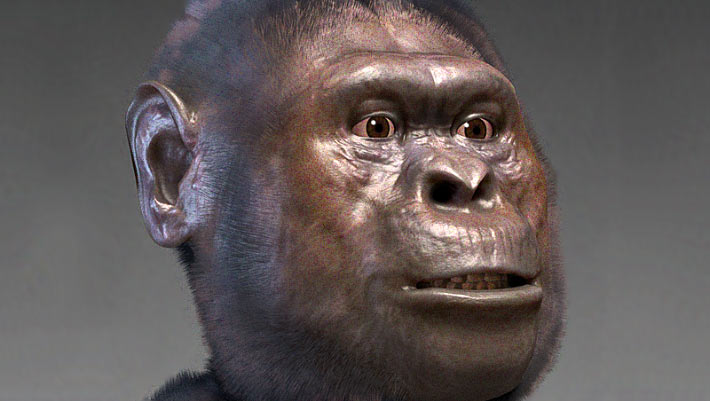New hominin fossils recovered from the Ledi-Geraru Research Project area in the Afar region of Ethiopia suggest the presence of early Homo at 2.78 and 2.59 million years ago and a previously unknown species of Australopithecus at 2.63 million years ago.
Forensic facial reconstruction of Australopithecus afarensis. Image credit: Cicero Moraes / CC BY-SA 3.0.
The time interval between about 3 and 2 million years ago is a critical period in human evolution.
This is when the genera Homo and Paranthropus first appear in the fossil record and a possible ancestor of these genera, Australopithecus afarensis, disappears.
“We used to think of human evolution as fairly linear, with a steady march from an ape-like ancestor to modern Homo sapiens,” said University of Nevada Las Vegas researcher Brian Villmoare and his colleagues.
“Instead, humans have branched out multiple times into different niches.”
“Our pattern of evolution is not particularly unusual, and what has happened to humans has happened to every other tree of life.”
“This is what we should be finding in the human fossil record.”
“Nature experimented with different ways to be a human as the climate became drier in East Africa, and earlier more ape-like species went extinct.”
Dr. Villmoare and co-authors found 13 hominin teeth at the Ledi-Geraru site in the Afar Region of Ethiopia.
They determined that, although some of these fossils belong to the genus Homo, a set of upper and lower teeth belong to a previously unknown species of the genus Australopithecus.
This new species is distinct from Australopithecus afarensis, which last appears at roughly 2.95 million years ago and was discovered in nearby Hadar.
“The presence of both species in the same location shows that human evolution is less linear and more tree-like,” Dr. Villmoare said.
The Ledi-Geraru site is the same field site where in 2013, paleoanthropologists discovered the jaw of the earliest Homo specimen ever found at 2.8 million years old.
“The new finds of Homo teeth from 2.6-2.8 million-year-old sediments confirm the antiquity of our lineage,” Dr. Villmoare said.
“We know what the teeth and mandible of the earliest Homo look like, but that’s it.”
“This emphasizes the critical importance of finding additional fossils to understand the differences between Australopithecus and Homo, and potentially how they were able to overlap in the fossil record at the same location.”
“The Afar region is still an active rifting environment,” said Dr. Christopher Campisano, a geologist at Arizona State University.
“There were a lot of volcanoes and tectonic activity and when these volcanoes erupted ash, the ash contained crystals called feldspars that allow the scientists to date them.”
“We can date the eruptions that were happening on the landscape when they’re deposited.”
“And we know that these fossils are interbed between those eruptions, so we can date units above and below the fossils.”
“We are dating the volcanic ash of the eruptions that were happening while they were on the landscape.”
“It is a critical time period for human evolution as this new paper shows,” said Arizona State University’s Professor Ramon Arrowsmith.
“The geology gives us the age and characteristics of the sedimentary deposits containing the fossils. It is essential for age control.”
“Whenever you have an exciting discovery, if you’re a paleontologist, you always know that you need more information,” said Dr. Kaye Reed, a paleoecologist at Arizona State University.
“You need more fossils. That’s why it’s an important field to train people in and for people to go out and find their own sites and find places that we haven’t found fossils yet.”
“More fossils will help us tell the story of what happened to our ancestors a long time ago — but because we’re the survivors we know that it happened to us.”
The discovery is reported in a paper published today in the journal Nature.
_____
B. Villmoare et al. New discoveries of Australopithecus and Homo from Ledi-Geraru, Ethiopia. Nature, published online August 13, 2025; doi: 10.1038/s41586-025-09390-4
